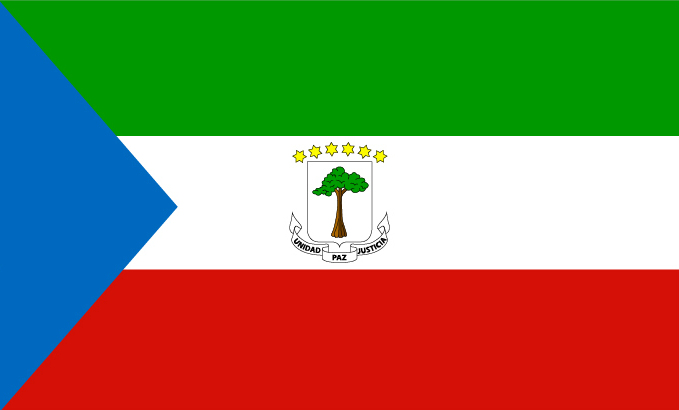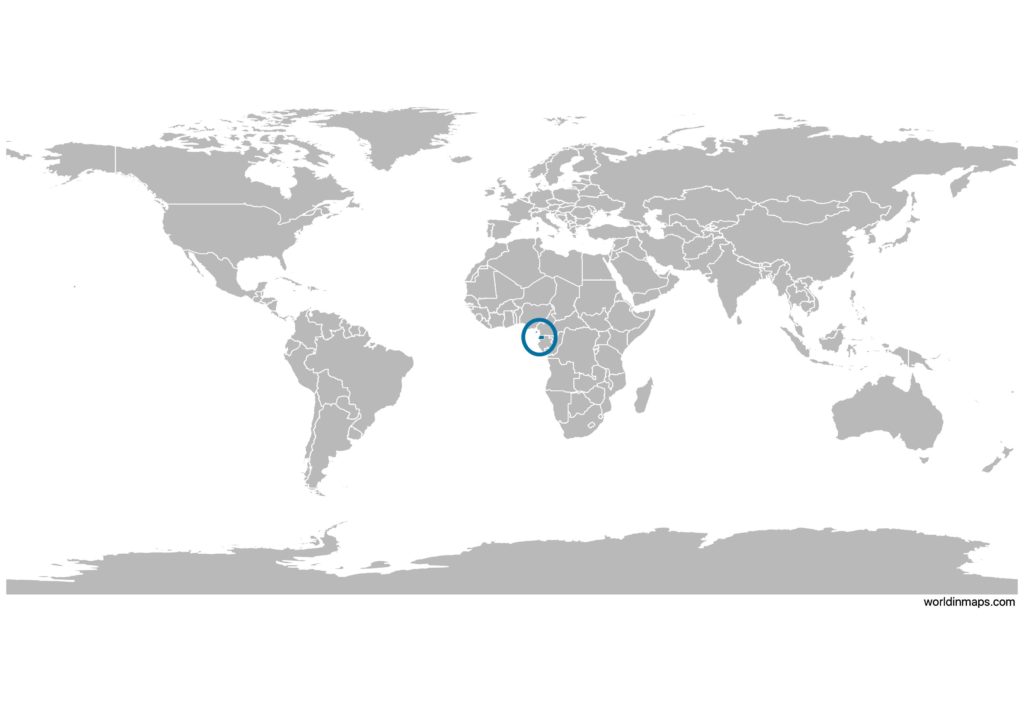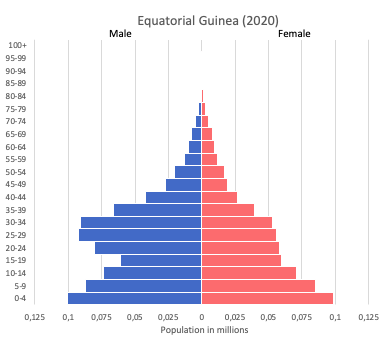Equatorial Guinea

| Government | |
| Name | Republic of Equatorial Guinea |
| Spanish | República de Guinea Ecuatorial |
| French | République de Guinée équatoriale |
| Portuguese | República da Guiné Equatorial |
| Government type | Presidential republic |
| Capital | Malabo (155,963 (2005)) |
| Currency | Central African CFA franc (XAF) |
| People | |
| Population (2020) | 1,402,985 |
| Density of population | 46.66 P/km2 |
| Nationality | Equatoguinean |
| Official languages | |
| Spanish | |
| Portuguese | |
| French | |
| Ethnic groups (1994) | |
| Fang | 85.7% |
| Bubi | 6.5% |
| Mdowe | 3.6% |
| Annobon | 1.6% |
| Bujeba | 1.1% |
| Other | 1.4% |
| Religions | |
| nominally Christian (predominantly Roman Catholic), Muslim, Baha’i, animist, indigenous | |
| Life expectancy (2020) | |
| Male | 64.4 years |
| Female | 66.9 years |
| Total population | 65.7 years (192nd) |
| Homicides | |
| n.a. | |
| Geography | |
| Land area | 28,051 km2 |
| water area | 0 km2 |
| total area | 28,051 km2 (146th) |
| Mean elevation | 577 m |
| Lowest point | |
| Atlantic Ocean | 0 m |
| Highest point | |
| Pico Basile | 3,008 m |
| Land use (2011) | |
| Agricultural land | 10.1% |
| Arable land | 4.3% |
| Permanent crops | 2.1% |
| Permanent pasture | 3.7% |
| Forest | 57.5% |
| Other | 32.4% |
| Urbanization | |
| Urban population (2020) | 73.1% |
| Rate of urbanization | 4.28% annual rate of change (2015 – 2020) |
| Economy | |
| Labor force (2007) | 195,200 (175th) |
| Labor force by occupation | |
| Agriculture | NA |
| Industry | NA |
| Services | NA |
| Unemployment rate (2014) | 8.6% (123rd) |
| GDP (PPP) (estimate 2019) | |
| Total | $29.162 billion |
| Per capita | $21,442 |
| GDP (nominal) (estimate 2019) | |
| Total | $12.432 billion |
| Per capita | $9,141 |
| GDP by sector (estimate 2017) | |
| Agriculture | 2.5% |
| Industry | 54.6% |
| Services | 42.9% |
| Exports (2017) | $6.118 billion (101st) |
| Exports partners (2017) | |
| China | 28% |
| India | 11.8% |
| South Korea | 10.3% |
| Portugal | 8.7% |
| US | 6.9% |
| Spain | 4.9% |
| Imports (2017) | $2.577 billion (155th) |
| Imports partners (2017) | |
| Spain | 20.5% |
| China | 19.4% |
| US | 13% |
| Cote d’Ivoire | 6.2% |
| Netherlands | 4.7% |
Equatorial Guinea on the world map

Equatorial Guinea top 10 largest cities (2005)
- Bata (173,046)
- Malabo (155,963)
- Ebebiyín (24,831)
- Aconibe (11,192)
- Añisoc (10,191)
- Luba (8,655)
- Evinayong (8,462)
- Mongomo (6,393)
- Mengomeyén (5,947)
- Micomeseng (5,813)
Demography
Population pyramid

Age structure data
Estimate for 2020:
- 0-14 years: 38.73% (male 164,417/female 159,400)
- 15-24 years: 19.94% (male 84,820/female 81,880)
- 25-54 years: 32.72% (male 137,632/female 135,973)
- 55-64 years: 4.69% (male 17,252/female 22,006)
- 65 years and over: 3.92% (male 13,464/female 19,334)
Remark: the age structure of a population affects a nation’s key socioeconomic issues. Countries with young populations (high percentage under age 15) need to invest more in schools, while countries with older populations (high percentage ages 65 and over) need to invest more in the health sector. The age structure can also be used to help predict potential political issues. For example, the rapid growth of a young adult population unable to find employment can lead to unrest.
Population from 1950 to 2020
Source: United Nations, Department of Economic and Social Affairs, Population Division (2019). World Population Prospects 2019, Online Edition. Rev. 1.
Evolution of the life expectancy from 1960 to 2018
Source: World Development Indicators, The World Bank
Economy
Agriculture:
coffee, cocoa, rice, yams, cassava (manioc, tapioca), bananas, palm oil nuts, livestock, timber
Industries:
petroleum, natural gas, sawmilling
Exports – commodities:
petroleum products, timber
Imports – commodities:
petroleum sector equipment, other equipment, construction materials, vehicles
Time zone and current time in Equatorial Guinea
Go to our interactive map to get the current time in Equatorial Guinea